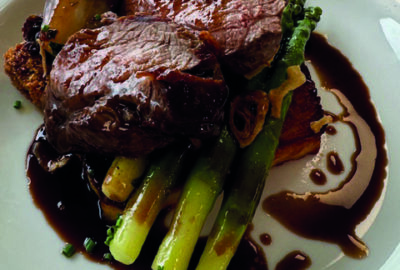By George McIvor, chairman of The Master Chefs of Great Britain
The Master Chefs of Great Britain was formed in 1980 to provide a forum for the exchange of culinary ideas and to further the profession through training and the guidance of young chefs. In addition, the association seeks to promote all that is best about British cuisine and produce. For more information on the association and the competitions and training opportunities they provide contact masterchefs@msn.com.
Official tasting notes
By New Covent Garden Market, the UK’s leading wholesale fruit and vegetable market www.newcoventgardenmarket.com
Properties: Figs have a unique, sweet taste, soft and chewy texture and are littered with slightly crunchy, edible seeds. Fresh figs are delicate and perishable, so are often dried to preserve. This produces a sweet and nutritious dried fruit that can be enjoyed all year round.
The fruit is, biologically speaking, not a single fruit at all, but more a thousand tiny fruits – the structures that look like seeds inside – which are attached to the inside of the fruit casing, called a “syconium”. The Bursa Black Fig is from Turkey, where all are grown in a small area around Bursa. The Turkish fig season runs from mid-August to mid-October. A fig tree produces multiple harvests of ripe fruit. The growers must pick the trees by hand at least half a dozen times per season. No pesticides and herbicides are used in the orchards.
Usage: Figs can be eaten fresh or dried, and used in jam-making. Most commercial production is in dried or otherwise processed forms. This is because the ripe fruit does not transport well, and once picked, does not keep well. The widely produced fig newton or fig roll is a biscuit with a filling made from figs. Eat raw, drizzled with honey, a scattering of toasted nuts and some cream as a dessert, or in a salad with cured meats or soft cheeses and rocket or similar salad leaves. Alternatively, halve and grill, or roast whole, or even poach whole. You can also use dried or raw figs for baking in pies, tarts and cakes, or just as a snack on their own.
Notes: Their natural sweetness meant that, before the days of refined sugars, they were often used as a sweetener.
1. Sweet idea Figs work beautifully with the sweet flavour of honey such as Tupelo Honey and Goat Cheese-Stuffed Figs.
2. Italian inspiration Give your figs an Italian twist by pairing them with salami, Parma ham and Italian cheeses to create delicious crostini.
3. Minted Try braising duck legs with figs, white balsamic vinegar and mint for an aromatic main. The full recipe is available at www.stiritupmagazine.co.uk/recipes.
4. First preserve For a delicious Palestinian-inspired jam, try making your own Dried Fig and Walnut Preserve.
Recipes reproduced with the permission of:
1. Gabrielle Langholtz (from ‘America The Cookbook’)
2. Linda Ly (from the New Camp Cookbook)
3. Paul Gayler (from his book ‘Chicken and other birds’)
4. Reem Kassis (from ‘The Palestine Table’)


